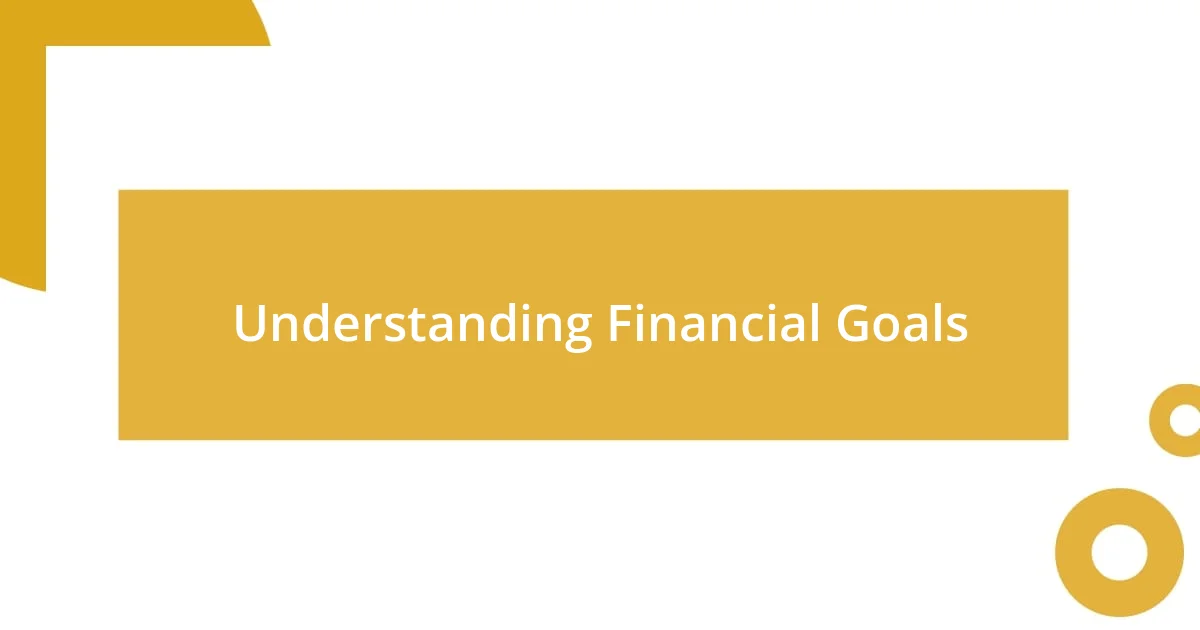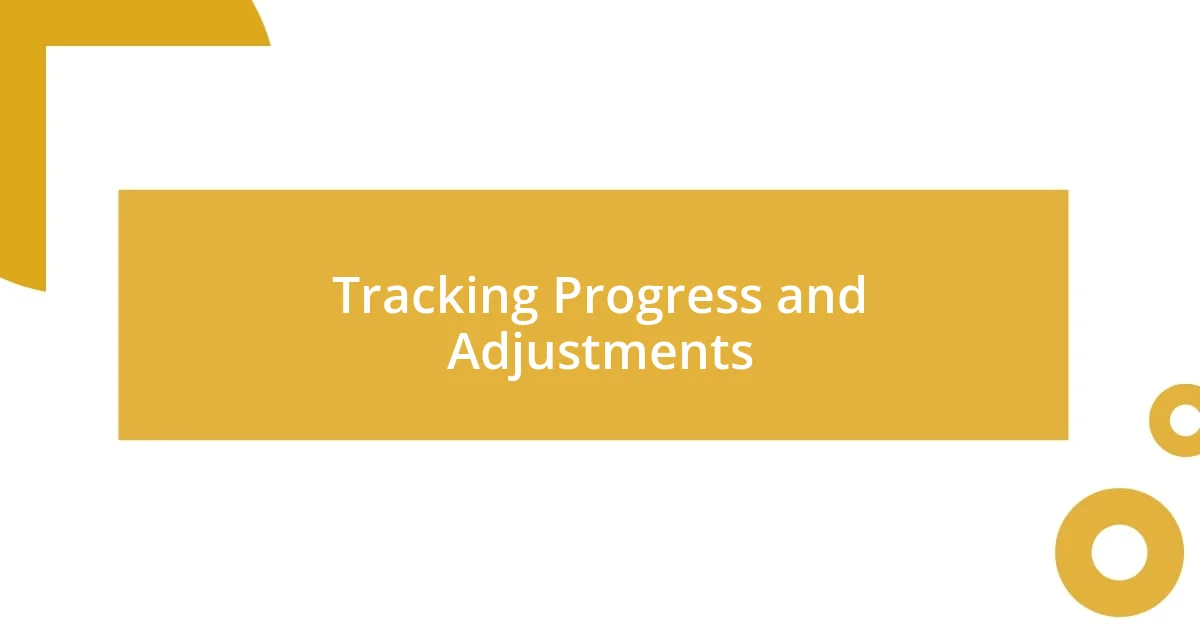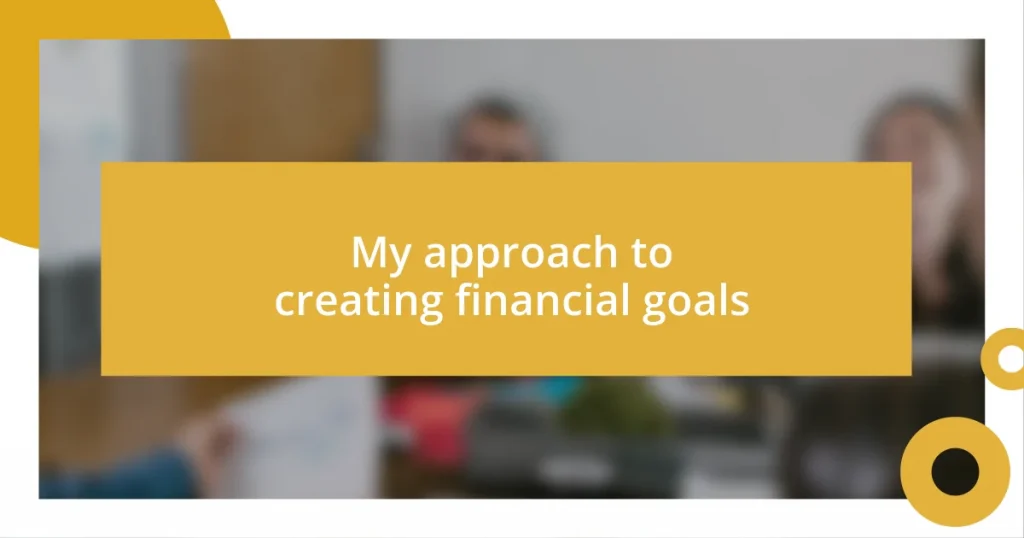Key takeaways:
- Establishing financial goals using the SMART framework (Specific, Measurable, Achievable, Relevant, Time-bound) enhances commitment and clarity in saving strategies.
- Regularly assessing your current financial situation, including income, expenses, debts, and assets, is crucial for crafting realistic and achievable financial goals.
- Celebrating milestones and acknowledging progress fosters motivation and resilience, making the financial journey more fulfilling and encouraging continuous improvement.

Understanding Financial Goals
Financial goals act as a guiding star for our monetary decisions, helping us map out where we want to go and how to get there. I remember the first time I set a goal to save for a vacation; it transformed my approach to spending. Rather than seeing money as a fleeting resource, I learned to view it as a tool to help me build experiences.
Understanding your financial goals means recognizing the difference between short-term desires and long-term dreams. For example, while I was thrilled to buy a new gadget, I soon realized that saving for a house would bring me lasting happiness. Have you ever found yourself prioritizing instant gratification over a bigger, more meaningful objective? Making that distinction can be a game-changer.
Visualizing your financial goals can also boost your motivation. When I created a vision board filled with images of my dream home and travel destinations, I felt more inspired to stick to my budget. Isn’t it fascinating how a clear image of what we truly want can fuel our financial decisions?

Setting SMART Goals
Setting SMART goals is a powerful framework that can clarify what we truly want to achieve financially. I remember when I first learned about the SMART criteria—Specific, Measurable, Achievable, Relevant, and Time-bound. It completely shifted my approach from vague intentions to concrete plans. For instance, instead of saying, “I want to save money,” I began to specify, “I will save $5,000 for a vacation by saving $416 each month for a year.” This detail made all the difference in my commitment.
To make the most of setting SMART goals, consider the following key elements:
- Specific: Define exactly what you want. For example, “I want to save for a car.”
- Measurable: Establish criteria to track your progress, such as “I will save $10,000.”
- Achievable: Set realistic goals based on your current situation. Think, “Can I really save this much?”
- Relevant: Ensure your goal aligns with your broader life objectives, like “This car will help me commute for work.”
- Time-bound: Set a deadline. An example would be, “I will achieve this by the end of next year.”
Seeing these aspects in action helped me not only refine my goals but also feel a sense of accomplishment when I ticked each box along the way.

Assessing Current Financial Situation
When it comes to assessing your current financial situation, it’s essential to take a clear-eyed look at where you stand. I always start by listing my income sources and expenses; this gives me a solid foundation for understanding my cash flow. It’s surprising how many small expenses can accumulate—are you aware of what truly drains your budget?
Next, I recommend reviewing your savings and debts. A few years back, I discovered that I had accumulated a seemingly harmless amount of credit card debt. It jolted me into action; I realized that without this awareness, I was simply drifting along. Have you assessed your debt-to-income ratio? It’s an eye-opening metric that can guide your financial strategies.
Then, consider your assets, such as savings accounts, investments, or property. When I finally took stock of what I possessed, it was liberating. I realized I had more to work with than I initially thought. Have you ever felt that way? It’s crucial for crafting realistic financial goals.
| Financial Aspect | Examples |
|---|---|
| Income | Salary, side hustles, passive income |
| Expenses | Rent, groceries, discretionary spending |
| Debts | Credit cards, student loans, mortgages |
| Assets | Savings, stocks, real estate |

Creating a Step-by-Step Plan
Creating a step-by-step plan is a fantastic way to bridge the gap between your goals and the actions required to achieve them. I’ve found that breaking my larger financial objectives into smaller, more manageable tasks not only makes the process less overwhelming but also boosts my motivation. For example, rather than focusing on saving for a house as a distant dream, I outline specific actions like researching mortgage options, saving for a down payment, and even meeting with a financial advisor.
As I developed my plan, I learned to take it one phase at a time, and it really helped me stay on track. I remember having a list of deadlines, like “Have my credit score improved by the summer” or “Save the first $2,000 by March.” These checkpoints served as guiding stars. Have you thought about what specific steps you could take toward your goals? It might be budgeting weekly, setting up automatic transfers to a savings account, or even enrolling in an investing course. Each of these actions creates a clear path toward achieving my larger objectives.
Reflection is also a crucial part of this planning process. Every month, I review my progress and evaluate what worked and what didn’t. For instance, I once underestimated how much I could save by cutting out a few restaurant meals. It was enlightening! I now adjust my plan based on my learning experiences, ensuring I remain flexible and responsive to my financial habits. How often do you give yourself that space to reflect and adjust your planning? Making this a routine has significantly enhanced my confidence and commitment to my financial journey.

Tracking Progress and Adjustments
Tracking my progress toward financial goals isn’t just about number crunching; it’s a personal journey. I remember the first time I set up a spreadsheet to monitor my savings. Each month, as I filled in those numbers, I felt a rush of excitement. I realized that seeing my progress visually made it more real and motivating. Have you ever celebrated a small win? Those little victories can make a world of difference!
As I track my progress, I also pay attention to determining when adjustments are necessary. I recall a moment when my initial savings goal felt like it was slipping away due to unexpected expenses. At first, it was a bit disheartening, but instead of giving up, I re-evaluated my situation. I adjusted my monthly savings target instead of abandoning my dream. This taught me the importance of flexibility; life is unpredictable, and our plans should be, too. How do you adapt your approach when things don’t go as planned?
Regular review sessions have become my go-to for ensuring I stay aligned with my goals. I like to set aside time every three months to look over my finances and reflect on my journey. During one of those sessions, I realized I hadn’t been as diligent with tracking my discretionary spending. That lightbulb moment prompted me to develop a better tracking system, which, in turn, gave me clearer insights into areas for improvement. Trust me, making it a habit to regularly evaluate and adjust can transform your approach to finances. What have you found works best for tracking and adjusting your goals?

Overcoming Common Obstacles
When it comes to overcoming common obstacles on my financial journey, I’ve learned that the most formidable barriers often stem from within. For instance, I can recall a time when self-doubt crept in, particularly when comparing my progress to others. It was frustrating to see friends seem to effortlessly achieve their goals while I felt stuck. But I’ve come to realize that everyone moves at their own pace. Have you ever felt that way? For me, acknowledging my unique path was a crucial step in regaining my motivation.
Life’s unpredictability can throw significant challenges my way, and I’ve often needed to adapt quickly. There was a moment when an unexpected car repair drastically affected my budget, throwing my financial goals off-kilter. I won’t lie; it shook my confidence. However, this setback taught me the importance of having an emergency fund. I began setting aside a small portion of my income each month for unforeseen expenses. So, how do you cushion yourself against surprises? Having a financial buffer can make all the difference, transforming potential disasters into manageable bumps in the road.
I also find that emotional resilience is essential when faced with setbacks. I remember feeling disheartened after months of sacrifices yielded minimal progress towards a savings goal. Instead of giving up, I took a moment to celebrate the small wins, like sticking to my budget and resisting impulse purchases. Reflecting on these achievements shifted my mindset from a sense of failure to one of persistence. What can you celebrate in your financial journey? It’s these tiny victories that fuel my determination, showing me that every bit of effort counts.

Celebrating Milestones and Successes
Celebrating milestones is an essential part of my financial goal journey. I vividly remember the moment I reached my first savings target. It wasn’t just a number; it felt like a mini victory dance for me. So, I treated myself to a night out—a simple celebration, but it meant the world. Isn’t it incredible how acknowledging these moments can give you that added motivation to keep pushing forward?
One thing I’ve found is that sharing my successes with friends adds a whole new layer of joy. When I reached a significant milestone last year, I organized a small gathering to toast our shared accomplishments—this included both mine and theirs. We all shared our stories, and it felt empowering to uplift one another. Have you thought about how sharing your wins could foster stronger connections?
Lastly, I’ve learned that reflection plays a key role in celebration. After hitting a major goal, I take time to revisit my journey, recognizing the obstacles I’ve overcome. I often jot down what I’ve learned, which reinforces my determination. I once spent a weekend writing a letter to my future self, outlining how I felt about my achievements. Hopefully, that served as a reminder of my resilience! How do you pause to acknowledge the hard work you’ve put in? Celebrating those achievements, no matter how small, can transform our mindset, making each step feel more meaningful.














